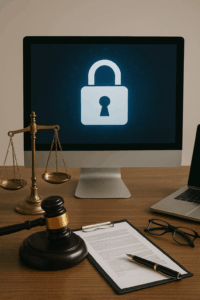Safeguarding sensitive information and protecting against cyber threats are critical for any organization. A key component of a robust cybersecurity strategy is the ability to effectively document and manage cyber incidents through detailed reporting. This article serves as a comprehensive guide to creating and managing cybersecurity incident reports.
In an increasingly interconnected world, cybersecurity incidents have become a significant concern for organizations of all sizes. These incidents, ranging from data breaches to sophisticated cyber attacks, can have devastating consequences, including financial losses, reputational damage, and legal liabilities. To effectively combat these threats, it is essential to have a well-structured approach to documenting and managing cyber incidents through detailed reporting.
A cybersecurity incident report plays a crucial role in this process, serving as a comprehensive record of any security breach or attack. This report not only helps in understanding the nature and impact of the incident but also provides a roadmap for preventing future occurrences. By meticulously documenting every aspect of a cyber incident, organizations can analyze vulnerabilities, enhance their defenses, and ensure compliance with regulatory requirements. In this guide, we will explore the essential components of a cybersecurity incident report and provide a step-by-step approach to creating one.
What is a Cybersecurity Incident Report?
A cybersecurity incident report is a detailed documentation of a security breach or cyber attack that provides a comprehensive overview of the incident. This report includes crucial information such as the nature of the incident, the affected systems, the extent of the damage, the response actions taken, and recommendations to prevent future incidents. It serves as an official record that helps organizations analyze security incidents and enhance their cybersecurity posture.
The nature of the incident typically involves identifying the type of cyber attack, such as a phishing attempt, malware infection, or denial of service attack. Understanding nature helps in categorizing the incident, which is crucial for analyzing trends and patterns in security breaches.
Affected systems refer to the specific hardware, software, networks, and data impacted by the incident. This information is vital for assessing the scope of the breach and identifying which parts of the organization’s infrastructure are most vulnerable. It also helps in prioritizing response efforts and allocating resources effectively.
The extent of the damage details the immediate and long-term impacts of the incident. This can include data loss, financial costs, operational disruptions, and reputational damage. By quantifying the damage, organizations can better understand the severity of the incident and plan for recovery and remediation.
Types of Cyber Incident Reports
Phishing Attacks
Phishing attacks are incidents where attackers use deceptive emails, messages, or websites to trick individuals into revealing sensitive information such as usernames, passwords, or financial details. These attacks often appear to come from legitimate sources, making them difficult to detect. A report on a phishing attack would include details of the deceptive content used, the method of delivery, the targeted individuals or departments, the information compromised, and the steps taken to mitigate the attack. It would also analyze how the phishing attempt was recognized and intercepted, and suggest measures to educate employees and improve email security protocols.
Malware Infections
Malware infections occur when malicious software infiltrates an organization’s systems, causing damage or unauthorized access. These can include viruses, worms, ransomware, and spyware. A malware infection report documents how the malware entered the system, the specific systems affected, the behavior of the malware, and the extent of the damage caused. It also details the response actions taken, such as isolating infected systems, removing the malware, and restoring data from backups. Recommendations for preventing future infections might include updating antivirus software, implementing stronger firewall rules, and educating employees on safe browsing practices.
Denial of Service (DoS) Attacks
Denial of Service (DoS) attacks are aimed at disrupting service availability by overwhelming systems, networks, or applications with excessive traffic. These attacks can render services unavailable to legitimate users and cause significant operational disruptions. A DoS attack report would describe the type and scale of the attack, the methods used to generate the traffic, the systems targeted, and the impact on service availability. It would also outline the steps taken to mitigate the attack, such as rate limiting, traffic filtering, and employing DoS protection services. The report would conclude with recommendations for enhancing network resilience and implementing robust monitoring to detect future DoS attempts.
Data Breaches
Data breaches involve unauthorized access to sensitive data, such as personal information, financial records, or proprietary business data. A data breach report provides a detailed account of how the breach occurred, the data compromised, the affected systems, and the extent of the exposure. It also includes the response actions taken, such as notifying affected individuals, securing the breached systems, and working with law enforcement or regulatory bodies. The report would also analyze the root cause of the breach and recommend improvements to data protection measures, such as encryption, access controls, and regular security audits.
Insider Threats
Insider threats are security incidents caused by employees or trusted individuals exploiting their access privileges to harm the organization. These threats can be intentional, such as data theft or sabotage, or unintentional, such as accidental data exposure. An insider threat report would detail the nature of the threat, the individual(s) involved, the systems and data affected, and the impact of the incident. It would also document the response actions taken, such as revoking access, conducting internal investigations, and implementing disciplinary measures. Recommendations for mitigating insider threats might include enhanced access controls, employee monitoring, and regular security training.
Advanced Persistent Threats (APTs)
Advanced Persistent Threats (APTs) are sophisticated, long-term cyber attacks aimed at stealing information or compromising critical systems. These attacks are often carried out by highly skilled attackers using advanced techniques to evade detection. An APT report would document the attack’s lifecycle, from initial intrusion to data exfiltration or system compromise. It would describe the methods used by the attackers, the systems targeted, and the impact on the organization. The report would also outline the response actions taken, such as threat hunting, system hardening, and collaboration with cybersecurity experts. Recommendations for preventing APTs might include deploying advanced threat detection tools, conducting regular security assessments, and improving incident response capabilities.
Explore our Managed Service Offerings
Worcester’s Top Managed Service Provider
Cyber Incident Reporting Requirements
Cyber incident reporting requirements can differ based on industry regulations, company policies, and geographical locations. Generally, these requirements include:
Timely Reporting
Incidents must be reported within a specific timeframe to regulatory bodies or affected stakeholders. Timely reporting ensures that necessary actions can be taken quickly to mitigate the impact of the incident and prevent further damage. Regulatory bodies often set strict deadlines for reporting, and failing to comply can result in penalties.
Detailed Documentation
Comprehensive details about the incident, including the timeline, nature, and impact, are essential for a thorough understanding of the event. Detailed documentation helps in analyzing the incident, identifying vulnerabilities, and improving security measures. It should include information on how the incident was detected, the response actions taken, and the resolution process.
Compliance with Standards
Adherence to industry standards such as GDPR, HIPAA, or ISO 27001 is crucial for ensuring that cyber incident reports meet regulatory requirements. These standards often dictate specific criteria for reporting, including what information must be included and how it should be communicated. Compliance with these standards helps organizations avoid legal repercussions and maintain trust with stakeholders.
Notification Protocols
Clear guidelines on whom to notify within and outside the organization, including regulatory authorities and affected individuals, are essential for effective incident management. Notification protocols ensure that all relevant parties are informed promptly and accurately, enabling coordinated response efforts. These protocols should include contact information, communication templates, and escalation procedures to streamline the notification process.
By adhering to these cyber incident reporting requirements, organizations can ensure that their incident reports are comprehensive, compliant, and effective in mitigating the impact of cyber threats.
Step-by-Step Guide in Creating a Cyber Incident Report
Creating an effective cyber incident report involves several key steps to ensure thorough documentation and analysis of the incident. This structured approach aids in managing the incident efficiently and improving future security measures.
Identify and Contain the Incident
Immediate actions are crucial to prevent the spread of the threat and minimize damage. This step involves isolating affected systems by disconnecting them from the network to prevent further infiltration by the attacker. It may also require shutting down compromised networks temporarily to stop ongoing malicious activities. Additionally, blocking malicious traffic using firewalls and intrusion prevention systems is essential to control the situation and limit the potential impact of the incident.
Gather Detailed Information
Once the incident is contained, it is important to gather all relevant data about the incident. This involves collecting logs from servers, network devices, security tools, and applications to understand the sequence of events. Identifying affected systems and listing all systems, applications, and data that were impacted by the incident is crucial. Determining any compromised data, including what was accessed, stolen, or altered, and collecting evidence such as malicious IP addresses, domains, and file hashes, are essential for a thorough analysis of the incident.
Document the Timeline
A precise timeline of events is vital for understanding the progression of the incident. This involves recording the date and time when the incident was first detected and documenting the sequence of events from initial detection to containment and resolution. Additionally, noting the timing of each response action taken to address the incident helps in reconstructing the incident and identifying any gaps in the response process.
Analyze the Impact
Assessing the impact of the incident on business operations, data integrity, and customer trust is a critical step. This involves determining how the incident affected business operations, including downtime, disrupted services, and productivity loss. Evaluating the integrity of any compromised, altered, or destroyed data is also crucial. Quantifying the financial losses incurred due to the incident, including response costs, lost revenue, and potential regulatory fines, and evaluating the potential reputational damage, including customer trust and brand image, helps in understanding the full extent of the damage and planning for recovery.
Describe the Incident
Providing a detailed description of the incident is essential. This includes identifying the type of attack, whether it was a phishing attack, malware infection, DoS attack, data breach, insider threat, or APT. Explaining how the attackers carried out the attack, including the tools and techniques used, and identifying any vulnerabilities that were exploited to carry out the attack, are crucial steps. This detailed description aids in understanding the nature of the attack and preventing similar incidents in the future.
Document Response Actions
Documenting the actions taken to mitigate the incident is necessary. This includes steps taken to contain and eradicate the threat, such as patching vulnerabilities, removing malware, and restoring affected systems. It also involves describing how the incident was communicated internally and externally, including notifying stakeholders and regulatory bodies. Any external help involved, such as cybersecurity consultants, law enforcement, or third-party vendors, should also be recorded to ensure that all response efforts are documented and can be reviewed for effectiveness.
Recovery and Lessons Learned
Outlining the steps taken to recover from the incident and restore normal operations is crucial. This includes actions taken to recover lost data, restore systems, and resume business operations. Highlighting key insights gained from the incident, including what went well and areas needing improvement, is essential. Recommendations for improving security measures, response plans, and employee training to prevent future incidents should also be included. This section is crucial for continuous improvement and strengthening the organization’s cybersecurity posture.
Review and Finalize
Finally, reviewing the report for accuracy and completeness is essential. Ensuring all information is accurate and consistent is necessary. Verifying that the report includes all required information and meets regulatory requirements and internal policies is crucial. Obtaining necessary approvals from relevant stakeholders before final submission and conducting a thorough review ensures the report is a reliable and valuable document for future reference and audit purposes.
Advantages of Preparing a Cyber Incident Report
Documentation of Events
A cyber incident report provides a detailed account of the incident, including the nature of the attack, affected systems, and response actions taken. This documentation serves as an official record that can be referenced for future analysis, audits, or legal proceedings.
Analysis for Improvement
By analyzing the incident and its impact, organizations can identify weaknesses in their security posture and implement measures to prevent similar incidents in the future. Incident reports help in understanding the tactics used by attackers, vulnerabilities exploited, and areas needing improvement.
Compliance with Regulations
Many industries have regulatory requirements mandating the reporting of cybersecurity incidents. By preparing a cyber incident report, organizations ensure compliance with relevant regulations such as GDPR, HIPAA, or PCI DSS, avoiding potential penalties and legal consequences.
Communication and Transparency
Incident reports facilitate communication and transparency within the organization and with external stakeholders. Clear documentation of the incident, response actions, and lessons learned fosters trust among employees, customers, partners, and regulatory authorities.
Continuous Improvement
ncident reports contribute to a culture of continuous improvement in cybersecurity practices. Organizations can use insights from incident reports to update policies, enhance security controls, and provide targeted training to employees, strengthening their overall security posture.
Disadvantages of Not Having a Cyber Incident Report
Lack of Accountability
Without a formal incident report, it may be challenging to assign responsibility for handling the incident or to track the effectiveness of response actions. This can lead to confusion, inefficiencies, and missed opportunities for improvement.
Inadequate Analysis
Without a structured incident report, organizations may fail to conduct a thorough analysis of the incident, including its root causes, impact, and lessons learned. This hinders their ability to identify and address underlying vulnerabilities, increasing the risk of future incidents.
Legal and Regulatory Risks
Failure to document cybersecurity incidents can result in legal and regulatory risks. Non-compliance with reporting requirements may lead to fines, penalties, or legal actions by regulatory authorities or affected parties, damaging the organization’s reputation and financial stability.
Reputation Damage
In the absence of transparent communication about cybersecurity incidents, organizations risk damaging their reputation and eroding trust with customers, partners, and stakeholders. Without clear documentation of the incident and response actions taken, stakeholders may perceive the organization as negligent or untrustworthy.
Missed Learning Opportunities
Without an incident report, organizations miss valuable learning opportunities to improve their cybersecurity practices. Insights gained from incident analysis, including vulnerabilities discovered and response effectiveness, are lost, hindering the organization’s ability to adapt and respond to evolving threats.
Discover our IT Solutions for Your Industry
Worcester’s Top Managed Service Provider
How Triton Technologies Can Help
At Triton Technologies, we specialize in providing comprehensive cybersecurity solutions tailored to the unique needs of your organization. Our suite of services is designed to enhance your security posture, ensure compliance, and foster a culture of cybersecurity awareness. Here’s how we can help:
Incident Response Planning
Effective incident response planning is crucial for minimizing the impact of cyber incidents. At Triton Technologies, we assist organizations in developing robust incident response plans that ensure quick and effective handling of cyber threats. Our experts work with you to identify potential vulnerabilities and create detailed protocols for detecting, containing, and mitigating incidents. By establishing clear roles and responsibilities and defining communication strategies, we ensure your team is prepared to respond swiftly and efficiently to any cyber attack.
Real-Time Monitoring
Timely detection of cyber threats is essential for preventing significant damage. Our advanced monitoring tools provide real-time detection and alerting capabilities, enabling swift action against potential threats. Triton Technologies utilizes cutting-edge technologies to continuously monitor your network, systems, and applications for unusual activity or signs of compromise. Our real-time monitoring solutions help you stay one step ahead of attackers, allowing you to respond to incidents before they escalate.
Expert Analysis
Understanding the root cause and impact of a cyber incident is critical for effective remediation and future prevention. Our team of cybersecurity experts conducts thorough investigations and detailed analysis of incidents to provide actionable insights. We utilize sophisticated forensic tools and methodologies to trace the origins of an attack, identify compromised systems, and assess the extent of the damage. Our expert analysis helps you understand the nature of the threat and implement targeted measures to strengthen your defenses.
Compliance Support
Navigating the complex landscape of industry regulations and standards can be challenging. Triton Technologies provides comprehensive IT compliance support to ensure your incident reporting practices meet all regulatory requirements. Whether you need to comply with GDPR, HIPAA, ISO 27001, or other standards, our specialists help you align your reporting processes with the necessary criteria. We assist in documenting incidents accurately and comprehensively, ensuring that your reports are complete, timely, and compliant with relevant regulations.
Training and Awareness
A well-informed team is your first line of defense against cyber threats. Triton Technologies offers extensive training programs to educate your staff on recognizing and responding to cyber threats effectively. Our training sessions cover a wide range of topics, including phishing awareness, safe browsing practices, data protection, and incident response protocols. By fostering a culture of cybersecurity awareness, we help your employees become vigilant defenders against potential attacks, significantly reducing the risk of human error leading to security breaches.
Comprehensive Cybersecurity Solutions
By partnering with Triton Technologies, you can enhance your cybersecurity defenses, ensure compliance with reporting requirements, and maintain the trust of your stakeholders. Our holistic approach to cybersecurity includes not only reactive measures but also proactive strategies to fortify your organization against emerging threats. We tailor our solutions to fit your specific needs, providing you with the tools and expertise necessary to safeguard your digital assets and maintain operational resilience in the face of cyber challenges. Whether you need assistance with incident response, real-time monitoring, compliance, or staff training, Triton Technologies is your trusted partner in achieving robust cybersecurity.
Regional Presence and Managed Services
Based in Worcester, MA, Triton Technologies proudly offers managed services across various towns in Massachusetts, as well as in Rhode Island, Connecticut, New York, the British Virgin Islands, and Dublin, Ireland. Our regional presence allows us to deliver localized support and personalized services to a diverse range of clients. By extending our expertise across these areas, we ensure that organizations of all sizes can benefit from our cutting-edge cybersecurity solutions and comprehensive managed services, enhancing their security posture and operational efficiency globally. Reach out to our IT experts now and learn more about our service offerings.
Discover Our Compliance Management Solutions
Worcester’s Leading Provider of Compliance Services



